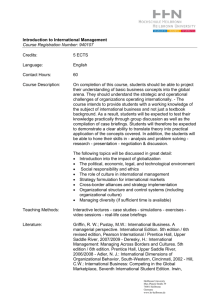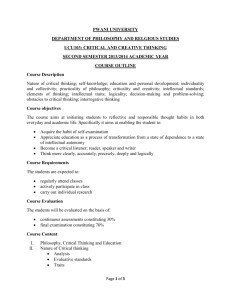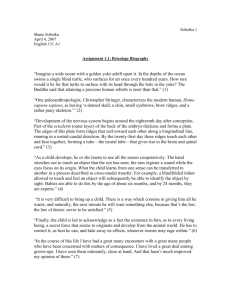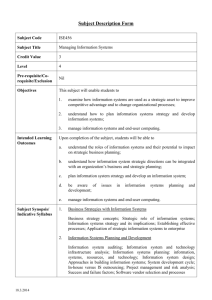Chapter 15, Heizer/Render, 5th and 7th edition
advertisement
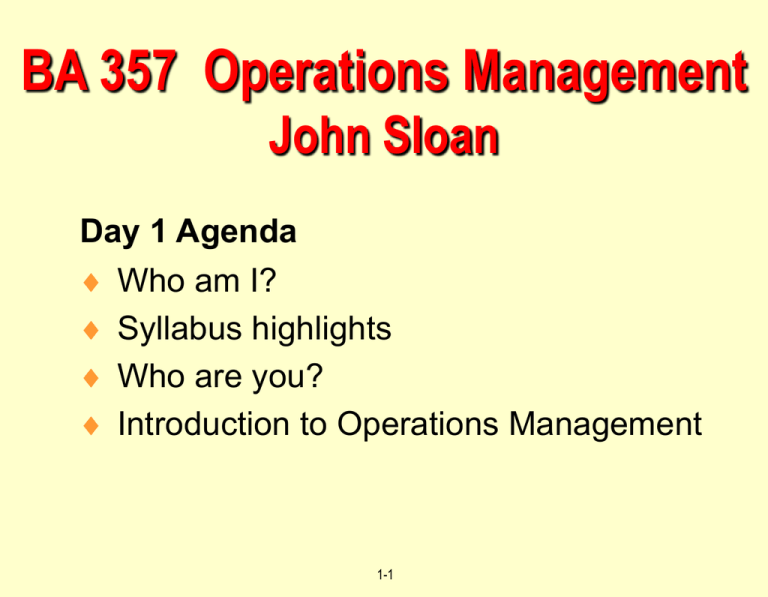
BA 357 Operations Management John Sloan Day 1 Agenda Who am I? Syllabus highlights Who are you? Introduction to Operations Management 1-1 © 2004 by Prentice Hall, Inc., Upper Saddle River, N.J. 07458 Who am I? Third year on the OSU Faculty, teaching BA 357, BA 462, and BA 550 28 years of operations / project management experience with Hewlett-Packard: Different geographical locations Different product lines Different functional responsibilities International experience Experience teaching in business setting BA Mathematics, 4 years USAF, MBA 1-2 © 2004 by Prentice Hall, Inc., Upper Saddle River, N.J. 07458 Syllabus Highlights Get the book Come to class. I will not formally take attendance – but if you don’t come, don’t expect to do well. Be prepared for class & participate in class Eight quizzes – You can drop one (1/3 of grade) Midterm exam (1/3 of grade) Final exam (1/3 of grade) All subject to change 1-3 © 2004 by Prentice Hall, Inc., Upper Saddle River, N.J. 07458 Policy on Cheating All students are expected to abide by the university rules on academic honesty, which forbid cheating or plagiarism. Failure to do so will result in failing the class. 1-4 © 2004 by Prentice Hall, Inc., Upper Saddle River, N.J. 07458 Schedule – BA 357 Section 4 Date Chapter / Topic Quiz / Assignment due 1/4/05 Introductions Syllabus review Ch 1: Introduction to Operations Management 1/6/05 Ch 2: Operations Strategy Regal Marine Video 1/11/05 Ch 3: Business Processes King Sooper Video 1/13/05 Supplement 7: Capacity Planning 1/18/05 Quantitative Module A: Decision-Making Tools Quiz 2 Homework 2 1/20/05 Ch 6: Quality Management Quiz 3 Homework 3 1/25/05 Ch 12: Inventory Management 1/27/05 Ch 16: JIT / Lean Systems Quiz 4 Homework 4 2/1/05 JIT Exercise 2/3/05 Midterm course review / Catch-up 2/8/05 Midterm exam Homework 1 Quiz 1 Two Canneries Video 1-5 © 2004 by Prentice Hall, Inc., Upper Saddle River, N.J. 07458 Schedule – p2 2/10/05 Quantitative Module D: Waiting Line Models 2/15/05 Quantitative Module F: Simulation 2/17/05 Supplement 11: SCM & E-Commerce 2/22/05 Ch 4: Forecasting 2/24/05 Ch 13: Aggregate Planning 3/1/05 Quiz 5 Homework 5 Quiz 6 Homework 6 Ch 14: MRP & ERP Quiz 7 Homework 7 3/3/05 Ch 14: MRP & ERP (continued) Ch 15: Short-Term Scheduling Quiz 8 Homework 8 3/8/05 Ch 3 (Heizer): Project Management 3/10/05 Sustainability Final course review 3/14/05 Final exam RM Video Air NZ Video Homework 9 7:30 AM 1-6 © 2004 by Prentice Hall, Inc., Upper Saddle River, N.J. 07458 Who Are You? Name and major Work experience I know it is early for some of you, but… What do you want to be doing once you graduate? 1-7 © 2004 by Prentice Hall, Inc., Upper Saddle River, N.J. 07458 Operations Management Introduction Chapter 1 1-8 © 2004 by Prentice Hall, Inc., Upper Saddle River, N.J. 07458 Operations & Operations Management Operations: the collection of people, technology, and systems within an organization that has primary responsibility for providing the organization’s products or services Operations management: the planning, scheduling, and control of the activities that transform inputs into finished goods and services 1-9 © 2004 by Prentice Hall, Inc., Upper Saddle River, N.J. 07458 Supply Chain & SCM Supply chain: the network of manufacturers and service providers that work together to move goods from the raw materials stage through to the end user. These manufacturers and service providers are linked together through physical flows, information flows, and monetary flows. Supply chain management: the active management of supply chain activities and relationships to maximize customer value and achieve a sustainable competitive advantage. It represents a conscious effort by a firm or group of firms to develop and run supply chains in the most effective and efficient ways possible. 1-10 © 2004 by Prentice Hall, Inc., Upper Saddle River, N.J. 07458 Processes and Operations Internal and external customers Inputs •Workers •Managers •Equipment •Facilities •Materials •Services •Land •Energy Processes and operations 1 Outputs 3 5 2 4 •Services •Goods Information on performance 1-11 © 2004 by Prentice Hall, Inc., Upper Saddle River, N.J. 07458 Goods vs. Services Goods Services Product Tangible Intangible Resale Yes No Inventory Raw materials, WIP, finished goods No – produced and consumed at same time Quality Relatively easy - consistent product definition Very hard – each customer different Customer Interaction Can be low Generally high Transportability Yes No Location Where convenient to produce Frequently centralized Convenient to customer Frequently dispersed Automation Yes Yes – 1-12 standardized services © 2004 by Prentice Hall, Inc., Upper Saddle River, N.J. 07458 Goods Contain Services & Services Contain Goods Automobile Computer Installed Carpeting Fast-food Meal Restaurant Meal Auto Repair Hospital Care Advertising Agency Investment Management Consulting Service Counseling 100 75 50 0 25 Percent of Product that is a Good 25 50 75 100 Percent of Product that is a Service 1-13 © 2004 by Prentice Hall, Inc., Upper Saddle River, N.J. 07458 Organization Chart General manager Marketing Manufacturing Finance/ Accounting Operations Production Control Quality Control 1-14 Purchasing © 2004 by Prentice Hall, Inc., Upper Saddle River, N.J. 07458 Some Cross-functional Linkages Engineering: what products and processes are needed Marketing: can we make what we wish to sell / what products cost the most to make / customer expectations Accounting: inventory management / JIT / work standards / cost verses price Finance: make verses buy / quantifying quality / cash flow and capital requirements / cost verses price Human resources: what skills do our employees need / who to hire / type of compensation to match strategy Information Systems: what information is needed and by whom / flow of goods / linkages to rest of supply chain 1-15 © 2004 by Prentice Hall, Inc., Upper Saddle River, N.J. 07458 Trends in Operations & SCM E-commerce improves speed, quality and cost of business communication Increased competition and globalization in markets increasing rate of change in markets, products and technology Relationship management of all operations activities, the most susceptible to break down The freethinking of one age is the common sense of the next Matthew Arnold (1822 – 1888) 1-16 © 2004 by Prentice Hall, Inc., Upper Saddle River, N.J. 07458 Why Study Operations Management? Every organization must make a product or provide a service that someone values Operations has primary responsibility for providing the organization’s products or services Most organizations function as part of larger supply chains Supply chains are networks of manufacturers and service providers that work together to move goods from the raw materials stage through to the end user Organizations must carefully manage their operations and supply chains in order to prosper, and indeed, survive Decisions and actions in operations directly affect company growth, market share, and profitability 1-17 © 2004 by Prentice Hall, Inc., Upper Saddle River, N.J. 07458 Why Study Operations Management? This is where the good or service comes into being – if you do not understand this part of the company, you are not being the best accountant, marketer, or whatever, that you could be. Strategies in all functional areas must be linked/aligned to support the business strategy. This is where companies focus a great deal of energy – because this is where most companies incur the majority of their costs. Therefore this is an area where you can have a major impact on a firm’s competitiveness. 1-18 © 2004 by Prentice Hall, Inc., Upper Saddle River, N.J. 07458 Options for Increasing Contribution Marketing Option Finance/Acct Option OM Option Current Sales + 50% Finance Costs – 50% Production Costs – 20% $100,000 $150,000 $100,000 $100,000 Cost of Goods -80,000 -120,000 -80,000 -64,000 Gross Margin 20,000 30,000 20,000 36,000 Finance Costs -6,000 -6,000 -3,000 -6,000 Net Margin 14,000 24,000 17,000 30,000 Taxes @ 25% -3,500 -6,000 -4,250 -7,500 Contribution 10,500 18,000 12,750 22,500 Sales 1-19 © 2004 by Prentice Hall, Inc., Upper Saddle River, N.J. 07458 Productivity Productivity = output / input (bigger is better) Single-factor productivity output / labor hours output / labor $ sales / sales rep sales / retail outlet, etc Multi-factor productivity output / (labor + material + overhead) Productivity Worksheet 1-20 © 2004 by Prentice Hall, Inc., Upper Saddle River, N.J. 07458 Conclusions for Day 1 OM is the management of the processes that add value directly to our goods and services. Functional area strategies must be linked to support the business strategy There is lots of money in improving operations Goods and services are part of the same continuum Productivity is the ratio of output to input, either single-factor or multi-factor. Homework assignment 1 in public folder 1-21 © 2004 by Prentice Hall, Inc., Upper Saddle River, N.J. 07458
